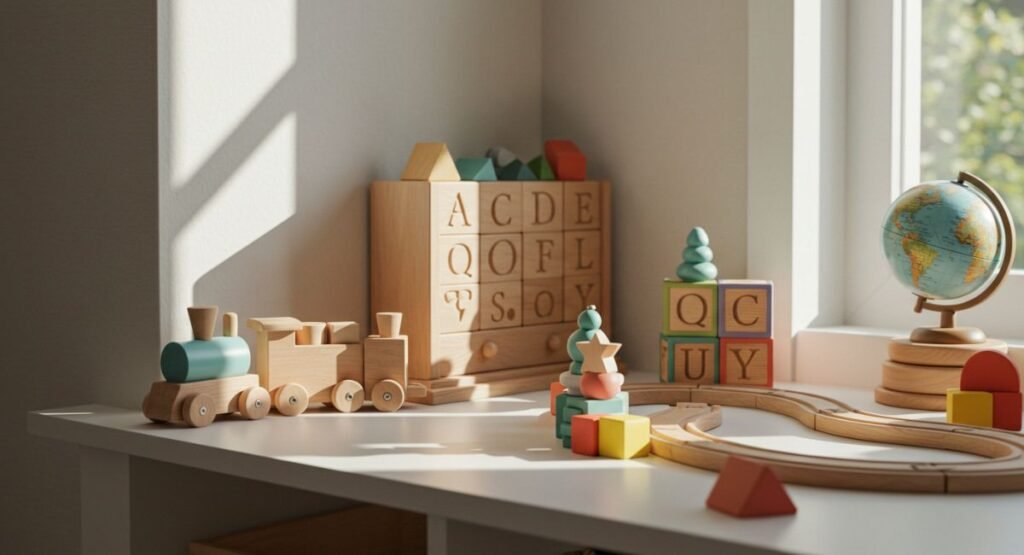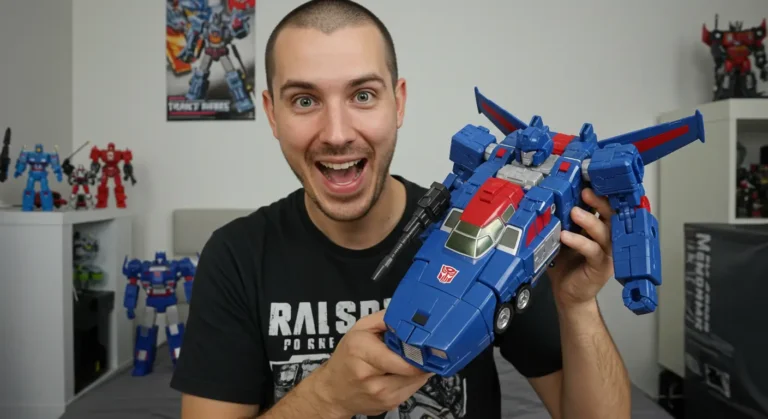Best Montessori Toys: The Age-by-Age Guide for Parents
Table of Contents
Are you searching for toys that don’t just entertain but actually help your child develop essential skills? Look no further than Montessori toys. These thoughtfully designed playthings have been captivating children and impressing parents for decades—and for good reason.
In this comprehensive guide, we’ll explore the best Montessori toys for different age groups, from infants to preschoolers. We’ll cover everything from sensory toys for babies to climbing structures for active toddlers, helping you make informed choices that support your child’s natural development.
What Are Montessori Toys?
Montessori toys aren’t just ordinary playthings—they’re carefully crafted learning tools based on the educational philosophy developed by Dr. Maria Montessori. These toys stand apart from conventional options in several important ways:
- Simple design: Montessori toys typically feature clean lines and minimal parts, allowing children to focus without overwhelming stimulation.
- Natural materials: Wood, cotton, wool, and other natural materials are preferred over plastic.
- Purpose-driven: Each toy serves a developmental purpose—whether it’s enhancing fine motor skills, encouraging problem-solving, or introducing real-world concepts.
- Child-directed play: Montessori toys don’t do the playing for the child. There are no batteries, flashing lights, or automatic features.
- Reality-based: They represent real objects rather than fantasy elements, helping children connect to their actual environment.
Montessori toys promote independent exploration, concentration, and mastery of skills. Rather than entertaining passively, they invite active engagement and discovery—making them among the best Montessori toys for supporting your child’s natural development.

Best Montessori Toys by Age Group
Children’s developmental needs evolve rapidly, especially in the early years. The Montessori approach recognizes these changing needs with age-appropriate materials that match a child’s current capabilities while gently challenging them to grow.
Let’s explore the ideal toys for each age range:
Best Toys for 4 Month Old Montessori
At four months, babies are becoming more aware of their surroundings and beginning to grasp objects. The best toys for 4 month old Montessori playtime focus on sensory experiences and emerging motor skills.
1. Wooden Montessori Rattle
A simple wooden rattle offers auditory stimulation while being gentle enough for young babies. The natural texture provides sensory feedback as they learn to grip.
Why I love it: These rattles are perfectly sized for tiny hands and made from smooth, safe wood that babies can safely mouth during teething.
2. Organic Cotton Sensory Ball
Soft fabric balls with contrasting colors and varied textures stimulate visual development and tactile exploration—key developmental areas for 4-month-olds.
Why I love it: The contrasting patterns support visual tracking skills, while the soft construction means babies can safely explore with their hands and mouth.
3. Wooden Play Gym
A wooden play gym with hanging elements encourages reaching, batting, and eventually grasping—perfect for developing coordination at this age.
Why I love it: Unlike plastic play gyms, these wooden versions offer natural beauty and can be customized with different hanging toys as your baby grows.
When selecting the best toys for 4 month old Montessori play, remember that less is more. A few high-quality items will serve your baby better than dozens of plastic toys competing for attention.
Best Montessori Toys for 1 Year Old
By their first birthday, children are typically mobile, exploring their environment with newfound independence. The best Montessori toys for 1 year old toddlers support this exciting developmental stage.
1. Object Permanence Box
This classic Montessori toy teaches that objects continue to exist even when out of sight—a concept babies master around this age.
Why I love it: The satisfaction of dropping the ball and finding it again builds cognitive skills and provides endless entertainment for curious one-year-olds.
2. Stacking Rings or Cups
Simple stacking toys develop hand-eye coordination, size discrimination, and spatial awareness—all crucial skills for toddlers.
Why I love it: stacking rings offer versatility, serving first as mouthing toys, then stacking challenges, and eventually props for imaginative play.

3. Push Walker
Walking is a major milestone around this age, and a well-designed wooden push walker provides stability while encouraging movement.
Why I love it: The best push walkers include features like adjustable resistance and additional activity panels, extending their usefulness as your child masters walking.
The best Montessori toys for 1 year old children should acknowledge their growing independence while providing just enough challenge to engage without frustrating.
Best Montessori Toys for 2 Year Olds
Two-year-olds are developing language, fine motor skills, and increasing independence. The best Montessori toys for 2 year olds respect their capabilities while channeling their energy constructively.
1. Wooden Practical Life Set
Miniature functional tools allow toddlers to mimic adult activities—a favorite pastime at this age.
Why I love it: These toys aren’t just fun—they teach real-life skills and responsibility, hallmarks of the Montessori approach.
2. Simple Wooden Puzzles
Puzzles with large, easy-to-grasp pieces develop problem-solving skills and hand-eye coordination. Look for options with 3-5 pieces to start.
Why I love it: Wooden puzzles with knobs are perfectly sized for toddler hands and offer a satisfying sensory experience compared to cardboard alternatives.
3. Sorting and Posting Toys
Shape sorters, posting boxes, and color sorting games help two-year-olds categorize their world—an important cognitive skill.
Why I love it: These toys teach shape and color recognition while developing the concentration and precision toddlers need for future learning.
When selecting the best Montessori toys for 2 year olds, look for options that can grow with your child, offering increasing levels of challenge as their skills develop.
Best Montessori Toys for 3 Year Olds
Three-year-olds have more sophisticated motor skills, longer attention spans, and blossoming imaginations. The best Montessori toys for 3 year olds nurture these developing capabilities.
1. Wooden Building Blocks
A good set of blocks is perhaps the ultimate Montessori toy—open-ended, versatile, and supportive of multiple developmental areas.
Why I love it: Blocks develop spatial awareness, early math concepts, and creative thinking all while being incredibly versatile.
2. Child-Sized Functional Tools
Real tools sized for small hands—like a functional watering can, small broom, or cooking utensils—satisfy the three-year-old’s desire to participate in “real” activities.
Why I love it: These aren’t pretend toys; they’re actual tools that work, giving children authentic experiences and a sense of accomplishment.
3. Beginner Board Games
Simple board games with clear rules teach turn-taking, following directions, and handling both winning and losing gracefully.
Why I love it: Games develop social skills and executive function in an enjoyable context—critical abilities for preschool success.
The best Montessori toys for 3 year olds respect the child’s growing competence while providing meaningful activities that satisfy their desire to contribute to the household.

Best Montessori Climbing Toys
Physical development deserves just as much attention as cognitive growth in a Montessori environment. The best Montessori climbing toys support gross motor development, balance, coordination, and body awareness—all while channeling toddlers’ boundless energy.
1. Pikler Triangle
This simple triangular climbing frame has become iconic in Montessori circles, and for good reason. It allows children to climb safely while building strength and confidence.
Why I love it: Pikler triangles are versatile and can be paired with ramps, slides, and other accessories for endless configurations as your child grows.
2. Climbing Arch
A curved climbing structure complements the Pikler triangle, offering different climbing challenges and possibilities for creative play.
Why I love it: The arch design teaches balance and can serve as a bridge, tunnel, or rocking boat in imaginative play scenarios.
3. Climbing Cube
Montessori climbing cubes feature multiple surfaces for climbing, sliding, and exploring, often with adjustable configurations.
Why I love it: These space-efficient structures pack multiple play options into a single piece of furniture that often looks attractive enough for your main living area.
The best Montessori climbing toys encourage physical confidence while developing crucial motor skills—all under your supervision, of course!
Top Montessori Toy Brands
While there are many manufacturers creating Montessori-aligned toys, several brands have distinguished themselves through consistent quality, thoughtful design, and commitment to Montessori principles:
Lovevery
Known for their subscription play kits tailored to specific developmental stages, Lovevery offers some of the best Montessori toys with research-backed designs and comprehensive play guides for parents.
Monti Kids
Monti Kids subscription service delivers genuine Montessori materials with video guidance, bringing the classroom experience home with high-quality wooden toys.
Grimm’s
Famous for their rainbow stackers and beautiful wooden toys with non-toxic dyes, Grimm’s creates open-ended playthings that grow with your child.
PlanToys
Committed to sustainability, PlanToys creates eco-friendly wooden toys that embody Montessori principles while maintaining responsible manufacturing practices.
Guidecraft
Guidecraft established company offers classroom-quality Montessori materials, including some of the best Montessori climbing toys designed for home use.
Investing in toys from reputable Montessori brands often means better quality, longer-lasting materials, and designs that truly support developmental goals.
Buying Tips for Parents
Finding the best Montessori toys for your child doesn’t have to be overwhelming. Here’s what to consider:
Age Appropriateness
Choose toys that match your child’s current abilities while offering just enough challenge to maintain interest. Too difficult, and your child may become frustrated; too easy, and they’ll quickly lose interest.
Materials Matter
Opt for natural materials like wood, cotton, and metal when possible. These provide richer sensory experiences than plastic and are generally more durable and environmentally friendly.
Quality Over Quantity
A few well-chosen, high-quality toys will serve your child better than dozens of lesser options. Montessori environments emphasize a curated selection rather than overwhelming abundance.
Rotation System
Consider implementing a toy rotation system, keeping only a few toys available at once. This maintains novelty, reduces overwhelm, and encourages deeper engagement with each item.
Follow Your Child’s Interests
The truly best Montessori toys for your specific child will align with their unique interests and developmental needs. Observe what captures their attention and build on those preferences.
For more comprehensive guidance on selecting appropriate toys, check out our detailed guide: 👉 How to Choose Montessori Toys
Conclusion
The best Montessori toys aren’t necessarily the most expensive or elaborate—they’re the ones that meet your child where they are developmentally while inviting them to grow and explore. From the best toys for 4 month old Montessori beginnings to engaging options for active preschoolers, the Montessori approach offers a thoughtful alternative to today’s often overwhelming toy market.
Remember that while toys are important tools, they’re just one aspect of creating a supportive environment for your child. Your engagement, observation, and responsiveness remain the most valuable elements in supporting your child’s development.
Whether you’re looking for the best Montessori toys for 1 year old explorers, searching for the best Montessori toys for 2 year olds with boundless energy, or seeking the best Montessori toys for 3 year olds with developing imaginations, the options we’ve shared provide excellent starting points for your Montessori journey.
Which Montessori toy has been your child’s favorite? Share your experiences in the comments below!
Frequently Asked Questions
What are Montessori toys?
Montessori toys are simple, purposeful playthings made primarily from natural materials. They’re designed to be self-correcting, developmentally appropriate, and focused on real-world concepts rather than fantasy elements.
Are Montessori toys suitable for all kids?
Yes! While developed as part of the Montessori educational method, these toys appeal to children’s natural development and can benefit any child. They’re especially valuable in today’s world of electronic and overstimulating toy options.
Why are wooden toys preferred in Montessori?
Wood provides natural sensory feedback (temperature, weight, texture) that plastic can’t replicate. Wooden toys are also typically more durable, environmentally friendly, and aesthetically pleasing, creating a calmer play environment.
How to Choose Montessori Toys?
When selecting Montessori toys, consider your child’s current interests and abilities, opt for natural materials, look for open-ended play possibilities, and choose items that connect to real-world experiences. For detailed guidance, check out our comprehensive resource: How to Choose Montessori Toys
Do I need special training to use Montessori toys with my child?
No special training is required! Simply provide the appropriate toys, demonstrate their use if needed, and then allow your child to explore independently. Observation is key—watch how your child interacts with the materials and follow their lead.
How many Montessori toys should my child have at once?
Less is more in the Montessori approach. Having 8-10 well-chosen toys available at any time prevents overwhelm and encourages deeper engagement with each item. Consider rotating toys every few weeks to maintain interest.


